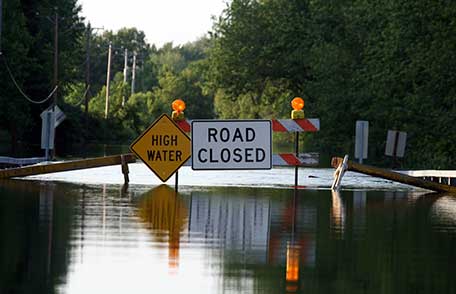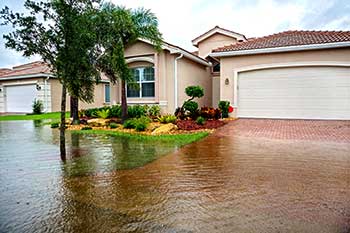Flood Safety Tips

Each year, more deaths occur because of flooding than any other hazard related to extreme precipitation events. Flood deaths occur most often when a vehicle is driven into hazardous floodwater. Fortunately, during and after a flood, you can take steps to protect yourself, your family, and your home.
During a Flood Watch or Warning
- Gather emergency supplies, including non-perishable food and water. Store at least 1 gallon of water per day for each person and each pet. Store at least a 3-day supply.
- Listen to your local radio or television station for updates.
- Have vaccination records handy (or know the year of your last tetanus shot).
- Store vaccination records in a waterproof container.
- Bring in outdoor items (lawn furniture, grills, trash cans) or tie them down securely.
- If it looks like you will need to evacuate, turn off all utilities at the main power switch and close the main gas valve.
- Leave areas subject to flooding such as low spots, canyons, washes, etc.

After you return home, if your home was flooded, practice safe cleaning.
After Flooding Occurs
- Don’t drive in or through flooded areas or standing water—cars or other vehicles won’t protect you from floodwaters. They can be swept away or may stall in moving water.
- Do not drink flood water, or use it to wash dishes, brush teeth, or wash or prepare food. Drink clean, safe water.
- If you evacuated, return to your home only after local authorities have said it is safe to do so.
- Listen for boil water advisories. Local authorities will let you know if your water is safe for drinking and bathing.
- During a water advisory, use only bottled, boiled, or treated water for drinking, cooking, etc.
- When in doubt, throw it out! Throw away any food and bottled water that comes or may have come into contact with floodwater.
- Prevent carbon monoxide (CO) poisoning. Use generators at least 20 feet from any doors, windows, or vents. If you use a pressure washer, be sure to keep the engine outdoors and 20 feet from windows, doors, or vents as well. Never run your car or truck inside a garage that is attached to a house even with the garage door open.
The initial damage caused by a flood is not the only risk. Standing floodwater can also spread infectious diseases, bring chemical hazards, and cause injuries.
After you return home, if your home was flooded, practice safe cleaning. Remove and throw out drywall and insulation that was contaminated with floodwater or sewage. Throw out items that cannot be washed and cleaned with a bleach solution, such as mattresses, pillows, carpeting, carpet padding, and stuffed toys. You may want to temporarily store items outside of the home until insurance claims can be filed. See recommendations by the Federal Emergency Management Agency (FEMA).
Clean walls, hard-surfaced floors, and other household surfaces with soap and water and disinfect with a solution of one cup of bleach to five gallons of water.